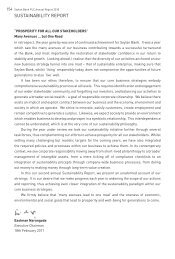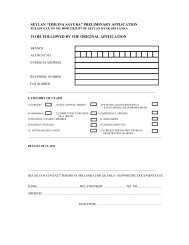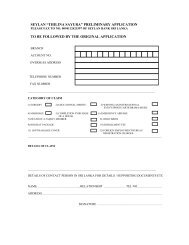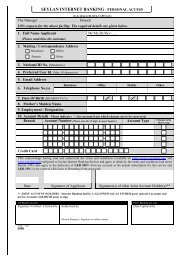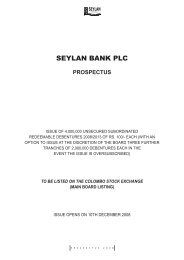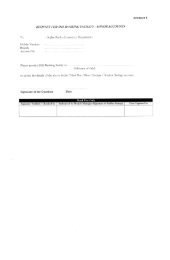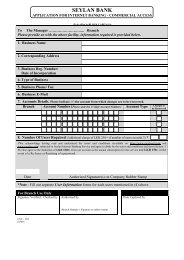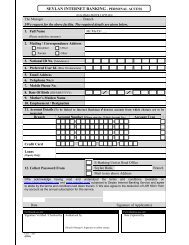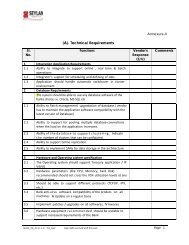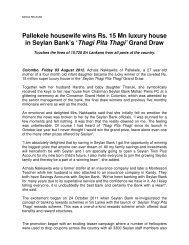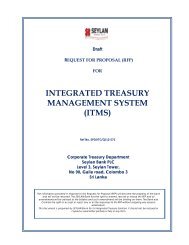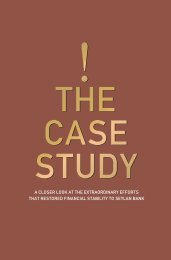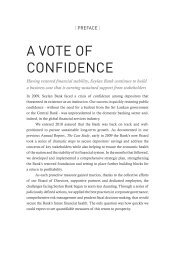Notes to the Consolidated Financial Statements - Seylan Bank
Notes to the Consolidated Financial Statements - Seylan Bank
Notes to the Consolidated Financial Statements - Seylan Bank
Create successful ePaper yourself
Turn your PDF publications into a flip-book with our unique Google optimized e-Paper software.
280 North Bound > <strong>Seylan</strong> <strong>Bank</strong> Annual Report 2011<br />
<strong>Notes</strong> <strong>to</strong> <strong>the</strong> <strong>Consolidated</strong> <strong>Financial</strong> <strong>Statements</strong><br />
3.3.10 Leased Assets - Lessee<br />
Leases in terms of which <strong>the</strong> Group assumes substantially all <strong>the</strong> risks and rewards of ownership are<br />
classified as finance leases. Upon initial recognition <strong>the</strong> leased asset is measured at an amount equal <strong>to</strong><br />
<strong>the</strong> lower of its fair value and <strong>the</strong> present value of <strong>the</strong> minimum lease payments. Subsequent <strong>to</strong> <strong>the</strong> initial<br />
recognition, <strong>the</strong> asset is accounted for in accordance with SLAS 19 - ‘Leases’.<br />
O<strong>the</strong>r leases are operating leases and, except for investment property, <strong>the</strong> leased assets are not<br />
recognised in <strong>the</strong> Group Balance Sheet.<br />
3.3.11 Impairment<br />
3.3.11.1 <strong>Financial</strong> Assets<br />
The <strong>Bank</strong> assesses at each Balance Sheet date whe<strong>the</strong>r <strong>the</strong>re is objective evidence that a financial asset is<br />
impaired. A financial asset is impaired and impairment losses are incurred if and only if, <strong>the</strong>re is objective<br />
evidence of impairment as a result of one or more loss events that occurred after <strong>the</strong> initial recognition<br />
of <strong>the</strong> asset and prior <strong>to</strong> <strong>the</strong> Balance Sheet date (‘a loss event’), and that loss event or events have had an<br />
impact on <strong>the</strong> estimated realisable value of <strong>the</strong> asset.<br />
The <strong>Bank</strong> assesses whe<strong>the</strong>r objective evidence of impairment exists for financial assets that are<br />
significant (except for loans and advance explained in Note 3.3.4). For loans and advances, impairment loss<br />
is measured individually and collectively as explained in Note 21.5.<br />
When a loan is uncollectible, it is written off against <strong>the</strong> related provision. Such loans are written off<br />
after all <strong>the</strong> necessary procedures have been completed and <strong>the</strong> amount of <strong>the</strong> loss has been determined.<br />
Subsequent recoveries of <strong>the</strong> amounts previously written off are included under ‘O<strong>the</strong>r Income’ in <strong>the</strong><br />
Income Statement.<br />
If, in a subsequent period, <strong>the</strong> amount of <strong>the</strong> impairment loss decreases and <strong>the</strong> decrease can be related<br />
objectively <strong>to</strong> an event occurring after <strong>the</strong> impairment was recognised, <strong>the</strong> previously recognised impairment<br />
loss is reversed by adjusting <strong>the</strong> impairment provision account. The amount of <strong>the</strong> reversal is recognised in<br />
<strong>the</strong> Income Statement.<br />
3.3.11.2 Non-<strong>Financial</strong> Assets<br />
The carrying values of Property, Plant & Equipment and Investment Properties are reviewed for impairment<br />
annually or when events or changes in circumstances indicate that <strong>the</strong> carrying value may not be recoverable.<br />
If such indications exist and where <strong>the</strong> carrying values exceed <strong>the</strong> estimated recoverable amount, <strong>the</strong> assets<br />
are written down <strong>to</strong> <strong>the</strong>ir recoverable amount. Impairment losses are recognised in <strong>the</strong> Income Statement,<br />
unless it reverses a previous revaluation surplus for <strong>the</strong> same asset.<br />
Assets with an indefinite useful life are not subject <strong>to</strong> amortisation and are tested on an annual basis<br />
for impairment and additionally whenever an indication of impairment exists. Assets that are subject <strong>to</strong><br />
amortisation are reviewed for impairment whenever events or changes in circumstances indicate that <strong>the</strong><br />
carrying amount may not be recoverable.<br />
The recoverable amount of an asset is <strong>the</strong> higher of its fair value, less cost <strong>to</strong> sell or its value in use. Any<br />
decrease in <strong>the</strong> carrying value is recognised as an expense in <strong>the</strong> Income Statement in <strong>the</strong> reporting period<br />
in which <strong>the</strong> impairment loss occurs.



